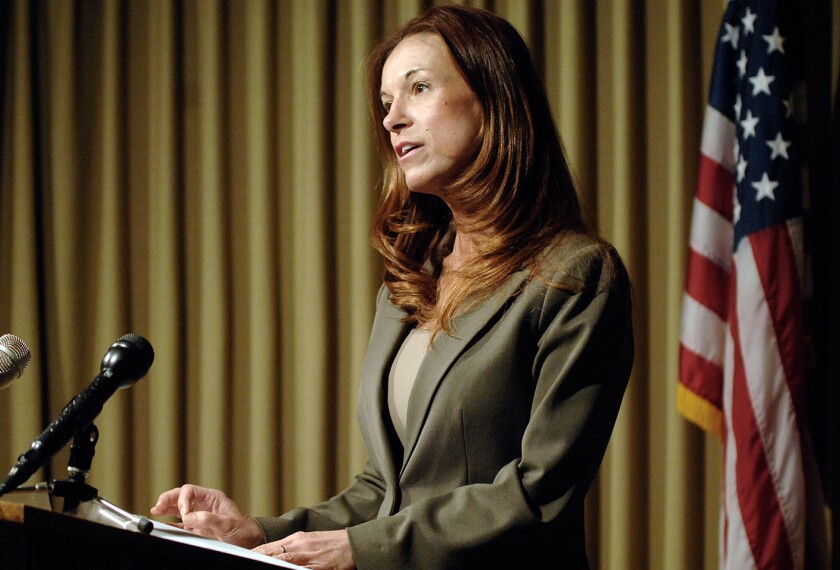The number of minority teachers receiving national certification shot up this year, suggesting that the advanced credential may have started to better penetrate schools serving poor, minority children.
Black teachers winning the stamp of approval from the National Board for Professional Teaching Standards rose by 24 percent, from 324 in 2005 to 403 last year, the privately organized group based in Arlington, Va., announced this month. Hispanic teachers, with 301 in the group that achieved certification last year, showed an increase of 13 percent over 2005.
In comparison, the number of white teachers awarded the credential grew by just 4 percent, from 6,208 in 2005 to 6,428 in 2006. Asian and Pacific Islander teachers stayed steady at about 100 each of those years.
Native American teachers had the largest percentage increase but the smallest numbers overall: 46 such teachers passed in 2005 and 69 last year, for a 50 percent increase.
African-American, Hispanic, and Native American teachers are more likely to work in schools with minority populations and low-income families, so increasing the number of teachers from those groups is likely to mean more teachers with the respected credential are working in low-income, low-performing schools.
“From the beginning, the board has had many discussions that because of the high cost of [the certification assessments] and where teachers go to teach, the suburbs would be providing us with candidates, and the urban centers and rural areas would not,” said Keith B. Geiger, the manager of state and local outreach for the board. As the president of the National Education Association, he served on the group’s governing board when it granted its first credentials in 1993 and 1994. “And guess what? That happened,” he said.
DREAM Team Enlisted
To counteract that effect, the board has put programs into place to help primarily minority candidates in urban and rural settings sign up and pay for certification, which costs $2,500. For most candidates, the assessment entails hundreds of hours of documentation and essay- writing, as well as a test.

SOURCE: National Board for Professional Teaching Standards
Joseph A. Aguerrebere Jr., the president and chief executive officer of the board, said it’s still too soon to know the programs’ effects. “A lot of these efforts are fairly new, and we don’t know yet whether our efforts were the primary reason for the increases,” he said.
As the number of national-board-certified teachers grows—currently exceeding 55,000, including those in minority groups—the word about the credential goes out more widely. The bonuses that are paid to nationally certified teachers in dozens of districts and some 30 states have also raised the credential’s profile. Yet those close to the board’s targeted initiatives believe those efforts have helped as well.
“We’ve been able to identify seeds that have sprouted,” said Joyce Loveless, the board’s director of program access and equity, citing recruitment undertakings, for instance, in Orangeburg, S.C., that have turned up enough candidates that the program is now focused on offering support during the assessment period. “I think [the programs] are making a difference.”
Ms. Loveless oversees some 20 locations where African-American, Hispanic, or Native American nationally certified teachers act as ambassadors and enablers for the program in high-needs districts, usually their own. The teachers receive training and an annual $1,500 stipend. Underwritten largely by the Hewlett-Packard Corp., the teachers have been dubbed the DREAM Team, with the acronym standing for Direct Recruitment Efforts to Attract Minorities. This is its third year.
The board targets other high-need districts with federal money that helps to pay the assessment fee, as well as for assistance with recruiting and supporting candidates. This year the 26 participating districts and states include some in every region of the country except New England.
Spreading the Word
Board officials have partnered with state education departments, teachers’ unions, businesses, and historically black colleges and universities, among others, to spread the message that accomplished minority teachers are needed, especially in high-needs schools, and are in short supply.
In one venture with North Carolina Agricultural and Technical State University in Greensboro, the board tracked down and re-recruited 11 minority teachers who had withdrawn from the program. They are preparing for the assessments with help from local nationally certified teachers from minority groups.
Stephanie Parker, a DREAM Team teacher in Birmingham, Ala., said that when she won her certification in 2001, she wondered why she was only one of two African-American teachers receiving the credential in her district. “Now, I’m becoming part of the solution,” she said. At formal meetings about board certification, as she visits schools in her capacity of district reading coach, at church and sorority gatherings, she’s spreading the word “on a daily basis,” she said.





